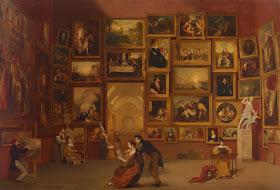The painting, The Best of the Louvre, showcases many pieces of art that were actually in the Louvre though they were not all in the same room. (Can you find the Mona Lisa?) In the center of the the painting you can see Morse looking over the shoulder of his daughter who is painting. Also pictured, in the left, is his friend and author, James Fenimore Cooper pictured with Cooper's wife and daughter.
In an interview with NPR's Susan Stamberg, author David McCullough said, ""It was an extremely ambitious undertaking because many of the paintings that he was copying were hung very high up. And so he had to build a movable platform, or scaffold, that he wheeled about the galleries of the Louvre to reach his subjects. And he and the movable scaffold became a tourist attraction themselves"
As to why the painting was created, David McCullough said, "There were no museums here, as yet, in the 1830s, and no color representations of paintings, so he was going to bring the culture of Europe — mainly the Renaissance Italian masterpieces in the Louvre collection — back to the United States for the benefit of his countrymen." (Quotes from the NPR site.)
As we also look forward to our trip to France this summer, I am really enjoying this painting! And, I'm looking forward to reading McCullough's new book, The Greater Journey: Americans in Paris. It is the story of Americans, from the year 1830 to 1900, who went to Paris to excel in their work - whether they were artists, authors, doctors, politians, etc.
P.S. Another great site about Morse and his art is found at the Terra Foundation for American Art website. www.terraamericanart.org under "collections".





